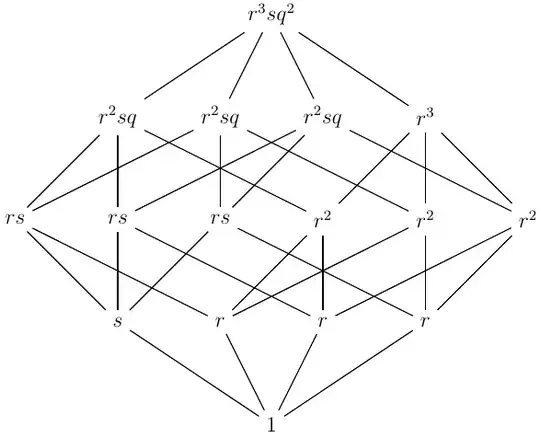Let $B_n$ be the subset lattice of $\{1,2, \dots , n \}$, also called the boolean lattice of rank $n$.
A labeling $f: B_n \to \mathbb{N}_{\ge 1}$ is called acceptable if $\forall a,b \in B_n$:
- $a < b \Rightarrow \frac{f(b)}{f(a)} \in \mathbb{N}_{\ge 2}$
- $ f(a)f(b) \le f(a \vee b)f(a \wedge b)$
Let $\varphi(f) := \sum_{a \in B_n} (-1)^{|a^{\complement}|}f(a)$ be the Euler totient of $f$.
Reminder (see this post and its answers): The divisor lattice of $m$ square-free is boolean of rank the number of prime factors of $m$ and $\varphi(f) = \varphi(m) > 0$. For $[H,G]$ boolean interval of finite groups, the labeling $f(K) = |K|$ is acceptable and $\varphi(f) > 0$ by Ore's theorem (for $G$ a Chevalley group and $H$ a Borel subgroup, $[H,G]$ is boolean of rank that of the Dynkin diagram of $G$). We know that at rank $\le 5$, $\varphi(f) > 0$ for any acceptable labeling $f$, but there are some at rank $6$ with $\varphi(f) < 0$.
Question: Is $\varphi(f)$ nonzero for any acceptable labeling $f$?
Motivation: A positive answer would give a purely combinatorial generalization of Ore's theorem.
Edit: We now request $a < b \Rightarrow \frac{f(b)}{f(a)} \in \mathbb{N}_{\ge 3}$, for two reasons:
- If there is an atom $K$ of $[H,G]$ boolean, such that $|K:H| = 2$, then $\forall T \in [H,K^{\complement}]$, $|T \vee K : T| = 2$, so that the Euler totient for $[H,G]$ equals the one for $[H,K^{\complement}]$.
- If we allow $\frac{f(b)}{f(a)}=2$, then there is a trivial infinite series of counter-examples: take $ m\ge 0$, then the $q$-deformation of the regular labeling (see the definitions in the accepted answer) for $$ r=2, \ s_1=2, \ n_1=2^{m+1}+4, \ s_2=2^{2^{m+1}+4+m}+1, \ n_2=1, \ q=2^m+1 $$
has rank $2^{m+1}+5$, and a zero Euler totient.
This question is related to tricky problems in modular arithmetic. We will give a series of non-trivial examples of acceptable labelings and prove that their Euler totient is nonzero:
Let $r,s,q \in \mathbb{N}_{\ge 2}$ with $r \wedge s = 1$. Consider the following labeling $f$ on $B_n$:
Take an atom $a$ of $B_n$, and label every maximal chain of $[\hat{0}, a^{\complement}]$ by $$(1, r, \dots, r^{n-1})$$ and every maximal chain of $[a,\hat{1}]$ by $$(s, rs, \dots, r^{n-3}s,r^{n-2}sq,r^{n-1}sq^2) $$
See below this labeling for $n=4$:
The labeling $f$ is obviously acceptable.
Proposition: The Euler totient $\varphi(f)$ is nonzero.
Proof: At rank $n+1$, we have $$\varphi(f) = s[(r-1)^{n}-(r^{n}-nr^{n-1})+(r^{n}q^2-nr^{n-1}q)]-(r-1)^{n}$$ $$= (s-1)(r-1)^{n} + sr^{n-1}(q-1)(r(q+1)-n)$$
So, $$\varphi(f) \equiv (s-1)(r-1)^{n} \mod r^{n-1}.$$ Now, assume that $\varphi(f) =0$, then $s\equiv 1 \mod r^{n-1}$, because $(r-1)\wedge r = 1$. So $s=k r^{n-1} + 1$ with $k \ge 1$. Then $$\varphi(f) = r^{n-1}[k(r-1)^{n} + (k r^{n-1} + 1)(q-1)(r(q+1)-n)]$$
Note that we must have $n < r(q+1)$ and $(r-1)^{n} > r^{n-1}$. It follows that $$3r+1 \le n \le \frac{ln(r-1)}{ln(1+\frac{1}{r-1})})$$ We deduce that $r \ge 24$ and $n \ge 73$, and also $n \le rln(r-1)$.
But $\varphi(f) =0$ implies that $$k(r-1)^{n} + (k r^{n-1} + 1)(q-1)(r(q+1)-n) \equiv (q-1)(r(q+1)-n) \equiv 0 \mod k$$ So there is $k'>0$ such that $(q-1)(r(q+1)-n) = -kk'$. It follows that $$\varphi(f) = r^{n-1}k[(r-1)^{n} - (k r^{n-1} + 1)k'] = 0$$ Then, $(r-1)^{n} = k'(k r^{n-1} + 1)$ and $k' \equiv (-1)^n \mod r$. So, $$(r-1)^{n} = (k''r+(-1)^n)(k r^{n-1} + 1)$$ with $k''\ge 0$. If $k'' \ge 1$, then $(r-1)^{n} \ge (r-1)(r^{n-1} + 1)>(r-1)^n$, contradiction. Then, $k'' = 0$, so $(-1)^n=1$, and $$(r-1)^{n} = k r^{n-1} + 1$$ So, it is necessary to have a solution for the following tricky equation
$$ (r-1)^{n} \equiv 1 \mod r^{n-1}$$
with $r \ge 24$ and $n \ge 3r+1 \ge 73$. By using arguments as in this answer, we deduce that:
- If $r \not \equiv 2 \mod 4$, then $2.2> \frac{2r}{r-2}>(1+\frac{1}{r-1})^n>(1+\frac{1}{r})^r>2.6$, contradiction.
- If $r \equiv 2 \mod 4$, then $m \ge r-2 = 2^mx \ge 2^m$ (with $x$ odd), contradiction.
It follows that $\varphi(f) \neq 0$. $\square$
Problem: Can we extend this proof to any acceptable labeling $f$?
